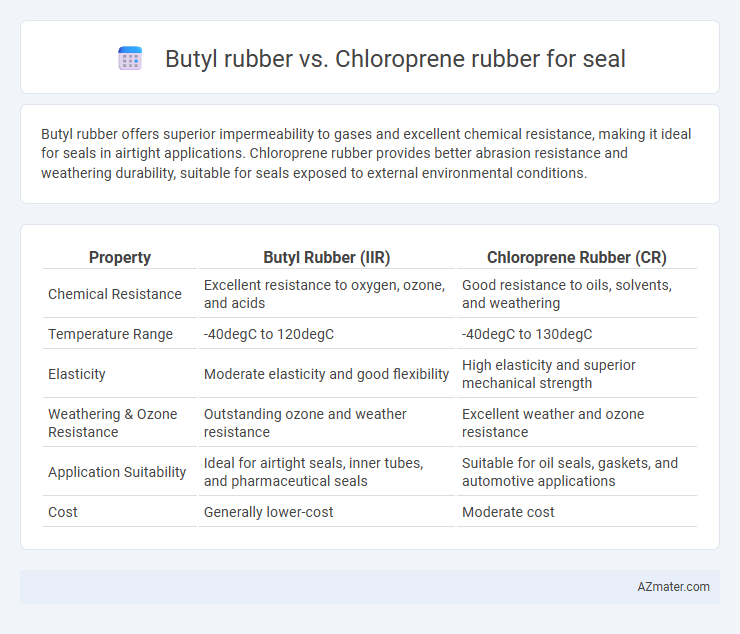Butyl rubber offers superior impermeability to gases and excellent chemical resistance, making it ideal for seals in airtight applications. Chloroprene rubber provides better abrasion resistance and weathering durability, suitable for seals exposed to external environmental conditions.
Table of Comparison
| Property | Butyl Rubber (IIR) | Chloroprene Rubber (CR) |
|---|---|---|
| Chemical Resistance | Excellent resistance to oxygen, ozone, and acids | Good resistance to oils, solvents, and weathering |
| Temperature Range | -40degC to 120degC | -40degC to 130degC |
| Elasticity | Moderate elasticity and good flexibility | High elasticity and superior mechanical strength |
| Weathering & Ozone Resistance | Outstanding ozone and weather resistance | Excellent weather and ozone resistance |
| Application Suitability | Ideal for airtight seals, inner tubes, and pharmaceutical seals | Suitable for oil seals, gaskets, and automotive applications |
| Cost | Generally lower-cost | Moderate cost |
Introduction to Butyl Rubber and Chloroprene Rubber
Butyl rubber is a synthetic elastomer known for its excellent impermeability to gases, making it ideal for seals requiring airtight and watertight properties. Chloroprene rubber, also known as Neoprene, offers superior chemical resistance, weatherability, and moderate oil resistance, suitable for seals exposed to harsh environmental conditions. Both materials provide resilient, durable sealing solutions, with butyl excelling in gas retention and chloroprene in environmental durability.
Chemical Composition and Structure Comparison
Butyl rubber is a copolymer of isobutylene with a small amount of isoprene, characterized by its saturated hydrocarbon backbone which provides excellent chemical resistance and low permeability. Chloroprene rubber, also known as neoprene, consists of polychloroprene units featuring chlorine atoms attached to the polymer chain, contributing to enhanced oil, heat, and weather resistance. The structural difference between the saturated chains of butyl rubber and the polychlorinated backbone of chloroprene rubber significantly influences their sealing performance in various chemical environments.
Key Physical Properties of Butyl vs Chloroprene Rubber
Butyl rubber exhibits superior impermeability to gases and excellent resistance to heat, ozone, and weathering, making it ideal for seals requiring airtight performance. Chloroprene rubber provides better tensile strength, abrasion resistance, and resilience, which benefits seals exposed to mechanical stress and rough conditions. Both elastomers offer distinct advantages depending on the sealing application's need for chemical resistance, flexibility, or durability.
Seal Performance in Extreme Temperatures
Butyl rubber exhibits excellent seal performance in extreme temperatures, maintaining flexibility and airtightness from -40degC to 120degC, making it ideal for cold and moderate heat applications. Chloroprene rubber (Neoprene) offers superior resistance to ozone, weathering, and fire, performing well in a temperature range of approximately -40degC to 100degC, with enhanced durability in dynamic sealing environments. For seals exposed to fluctuating temperatures and outdoor conditions, chloroprene provides a balanced combination of chemical stability and mechanical resilience, while butyl excels in gas impermeability and chemical resistance at low temperatures.
Resistance to Chemicals and Weathering
Butyl rubber exhibits superior resistance to a wide range of chemicals, including acids, alkalis, and polar solvents, making it highly effective for seals exposed to aggressive chemical environments. Chloroprene rubber offers excellent weathering resistance, maintaining flexibility and durability under prolonged exposure to UV radiation, ozone, and extreme temperatures. For applications requiring robust chemical resistance, butyl seals excel, whereas chloroprene seals are preferable in outdoor or harsh weather conditions.
Durability and Lifespan in Sealing Applications
Butyl rubber offers superior resistance to gases, moisture, and chemicals, making it highly durable for sealing applications exposed to harsh environments. Chloroprene rubber provides excellent resistance to weathering, ozone, and moderate chemicals, ensuring a longer lifespan in outdoor seals. For seals requiring enhanced durability against permeation and aging, butyl rubber often outperforms chloroprene in longevity and reliability.
Flexibility and Compression Set: Which is Better?
Butyl rubber offers superior flexibility and exceptional resistance to compression set, making it ideal for sealing applications requiring long-term resilience and minimal deformation under pressure. Chloroprene rubber, while providing good elasticity and moderate compression set resistance, tends to harden faster under prolonged stress and extreme temperatures compared to butyl rubber. For seals demanding enhanced flexibility and durability against permanent deformation, butyl rubber is generally the better choice.
Typical Industrial Applications for Butyl and Chloroprene Seals
Butyl rubber seals are commonly used in automotive and pharmaceutical industries due to their excellent airtightness and resistance to chemicals, making them ideal for tire inner liners, pharmaceutical stoppers, and protective gloves. Chloroprene rubber seals excel in oil, weather, and ozone resistance, making them suitable for HVAC systems, refrigeration, and oil-resistant gaskets in industrial machinery. Both materials offer distinct advantages, with butyl preferred for impermeability and chemical resistance, while chloroprene is favored for durability under environmental exposure.
Cost-Effectiveness and Availability Considerations
Butyl rubber offers superior cost-effectiveness for seals due to its lower raw material and production expenses compared to chloroprene rubber, making it ideal for budget-sensitive applications. Chloroprene rubber provides greater availability globally with a well-established supply chain, ensuring consistent material access for large-scale sealing projects. Evaluating the trade-off between butyl rubber's affordability and chloroprene's widespread availability is crucial for optimizing seal performance and overall project cost-efficiency.
Choosing the Right Rubber for Seal Performance Needs
Butyl rubber offers superior impermeability to gases and excellent resistance to ozone, weathering, and chemicals, making it ideal for seals in automotive and pharmaceutical applications requiring airtight performance. Chloroprene rubber (Neoprene) provides a balanced combination of flexibility, oil and heat resistance, and good mechanical properties, suitable for seals exposed to oils, fuels, and moderate weather conditions. Selecting between butyl and chloroprene rubber depends on the specific environmental stressors and chemical exposures to optimize seal longevity and performance.

Infographic: Butyl rubber vs Chloroprene rubber for Seal
 azmater.com
azmater.com